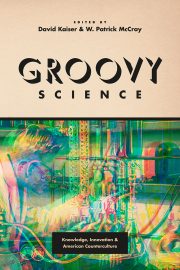Even if today many fans (and critics) of the 1960s and 1970s and the “counterculture” hold the believe that this generation, and those involved in social change were mostly anti-scientific and anti-technology, this view of the era is largely wrong. 
We know for a fact that back then many alternative ways of coping with life, philosophy, the idea of communal living and spirituality were imported or invented.
While fresh input, obviously often derived from experiences with mind expanding drugs, the contact with Eastern religion and philosophy, led to a number of far-reaching innovations in science.
Editors Kaiser and McCray compiled a history of those innovations and approaches: improved surfboards, home cheese-making, dolphin communication, a new type of midwifes and many other novelties. Many scientists, who, led by drugs, interest for sex, utopian ideas, strange design ideas from science-fiction literature and an altogether fresh interest in research unheard of in earlier times simply changed the world.
“In ignoring or sidelining these visionaries [hippies and freaks at this time], many of whom were fueled by a combustible mix of LSD and social isolation, mainstream historians of recent American history have missed a big story about how a substantial subset of Americans came to rethink how they eat, how they communicate, how they stay healthy. How they design and build, and how they have fun.” And just because the seventies offered a completely new way of looking at things and then simply declared weird combinations of interdisciplinary origins on the level with “square” approaches to problem solving. This also resulted in a number of innovative small start-ups. In order to understand those times, it is necessary to know that many research budgets were cut (except the ones for military purposes), science in general had lost much of its appeal and attractiveness and the war in Southeast Asia was not only a major topic in the news but also was the reason for cut national research budgets and a lack of attention for ongoing scientific research.
At this time, private sponsors and civilian agencies offered help and were gladly welcomed by the scientists, who, according to some changes and the zeitgeist, wanted to distance themselves as well as their work from the government and military ends.
Hard to believe, but reading Groovy Science actually was fun; it may also be fun for other readers, who are not really into science and technology but prefer topics from the humanities. However, these thinkers who are the stars of Kaiser’s and McCray’s book, very strongly shaped the counterculture, that, in turn, has had a huge influence on today’s mainstream culture. Those changes naturally were tied to the particular times. (Imagine a long-haired physicist or a biologist experimenting with drugs, listening to psychedelic rock music and going surfing in 1949… or in 1955…).
Nonetheless, at this particular time in the ”long 1970s,” many disciplines simply communicated very easily and scientists responsible for budgets, laboratory time or project goals just took the chance and realized (the possibilities for) the big picture, where many ideas from a different mindset could solve tangible problems.
Review by Dr. A. Ebert © 2017
David Kaiser and W. Patrick McCray (eds.) Groovy Science: Knowledge, Innovation, and American Counterculture. University Of Chicago Press, 2016, 432 p.
